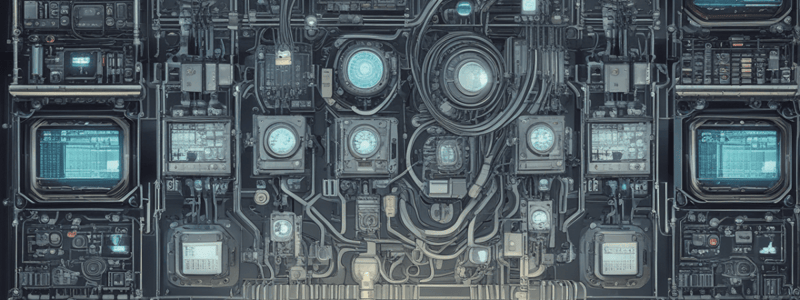Podcast
Questions and Answers
What system is best suited to help visualize a machine's performance and respond to issues in a factory?
What system is best suited to help visualize a machine's performance and respond to issues in a factory?
- HMI
- DCS (correct)
- PLC
- SCADA
Which system is ideal for designing a new steel plant with various processes like furnaces and rolling mills?
Which system is ideal for designing a new steel plant with various processes like furnaces and rolling mills?
- PLC
- DCS (correct)
- HMI
- SCADA
What system is best suited to monitor and control a steel plant with various processes, each equipped with its own controller?
What system is best suited to monitor and control a steel plant with various processes, each equipped with its own controller?
- PLC
- DCS (correct)
- SCADA
- HMI
What is the primary function of an HMI system?
What is the primary function of an HMI system?
Which system is used to control individual machines or devices?
Which system is used to control individual machines or devices?
What system is used to monitor and control large-scale industrial processes?
What system is used to monitor and control large-scale industrial processes?
Which system is used to monitor and control a large-scale industrial process with multiple components?
Which system is used to monitor and control a large-scale industrial process with multiple components?
What is the primary difference between a DCS and a PLC system?
What is the primary difference between a DCS and a PLC system?
Which system is used to monitor and control a large-scale industrial process with multiple locations?
Which system is used to monitor and control a large-scale industrial process with multiple locations?
What system is used to integrate multiple PLC systems?
What system is used to integrate multiple PLC systems?
Flashcards are hidden until you start studying
Study Notes
PLC Graphical Interface
- Efficient communication between humans and machines is essential in automation systems.
- Human-Machine Interface (HMI) serves as the vital link between humans and machines.
- HMI provides graphical interfaces to monitor and control industrial processes or equipment.
- HMI presents real-time data and system controls on a single screen.
HMI Definition and Function
- HMI stands for Human-Machine Interface.
- HMI enables operators to monitor and control industrial processes or equipment.
- HMI provides access to process data and allows operators to input commands executed by PLCs.
HMI Connection and Programming
- Inputs and outputs are connected to the PLC, and then the HMI is linked to the PLC to carry out tasks.
- PLCs are programmed to manage input/output signals and control logic.
- HMIs are programmed to create graphical interfaces to monitor and control processes.
DCS (Distributed Control System)
- DCS is used for large-scale and efficient control of complex processes in modern industries.
- DCS consists of multiple controllers distributed throughout a factory to control different interrelated processes.
- All controllers are interconnected with other devices, forming a network to control and monitor the whole factory.
DCS Construction
- In a factory environment, a DCS supervises several areas, each with its own set of inputs and outputs.
- DCS enables centralized control and monitoring of different areas across the factory.
- A DCS controller is responsible for executing control algorithms, managing input and output signals, and communicating with other devices within the network.
- A DCS control room includes components for monitoring and controlling industrial processes, such as engineering workstations, operator screens, and other devices.
DCS Advantages and Disadvantages
- Advantages:
- Centralized control and monitoring
- Scalability
- Redundancy
- Integration
- Real-time monitoring
- Disadvantages:
- Cost
- Complexity
- Maintenance
- Cybersecurity threats
SCADA (Supervisory Control And Data Acquisition) System
- SCADA is a system architecture that uses controllers, computers, communications, and graphical user interfaces to monitor and control different processes.
- SCADA is used to supervise non-DCS systems within a factory or remotely across different locations.
- SCADA construction involves:
- Data acquisition from various sensors and devices
- Data communication through wired or wireless methods
- Data presentation to operators
- Control of the system by operators
Scenario Answers
- Scenario (1): c. SCADA
- Scenario (2): a. HMI
- Scenario (3): d. DCS
- Scenario (4): c. SCADA
Studying That Suits You
Use AI to generate personalized quizzes and flashcards to suit your learning preferences.



